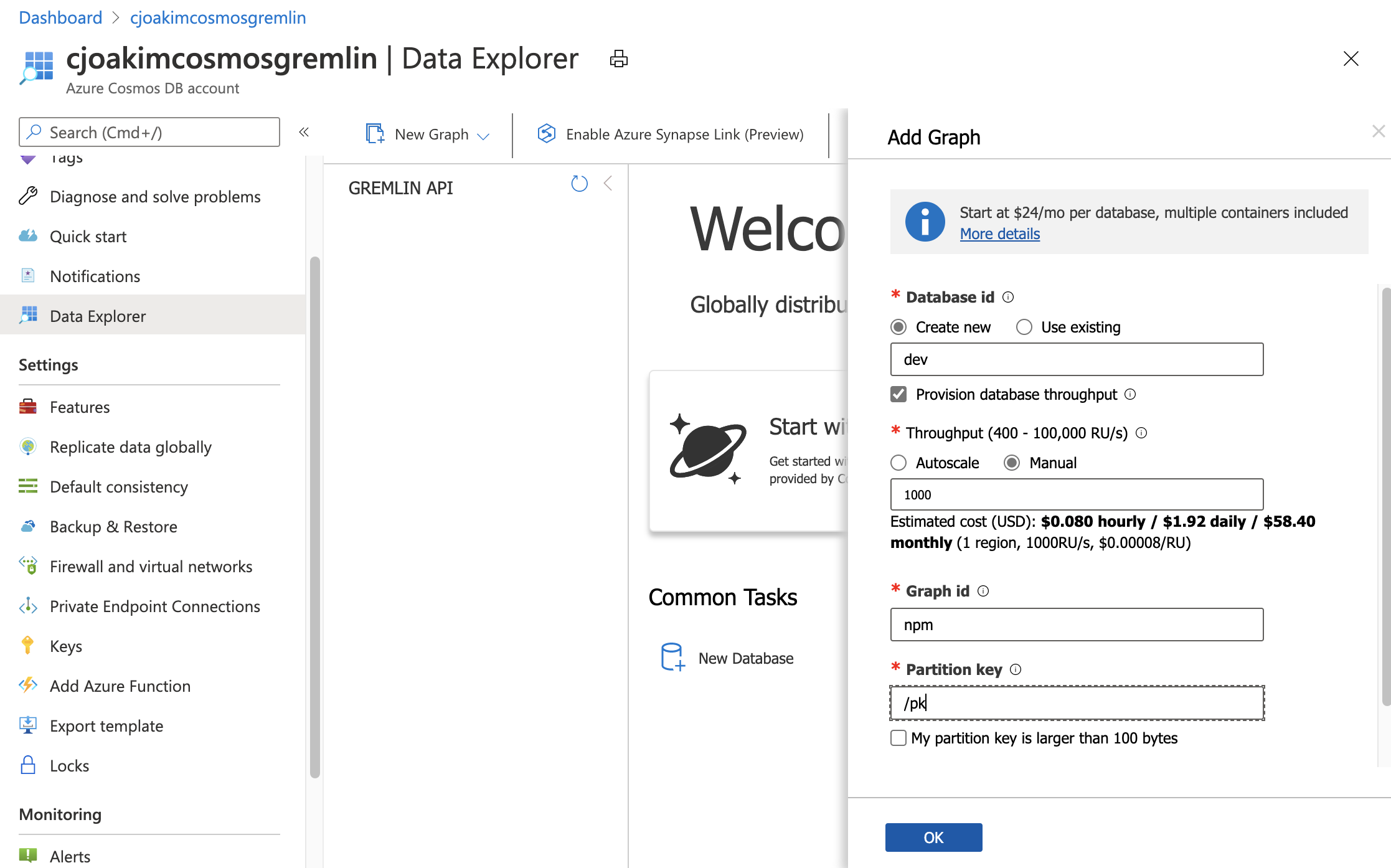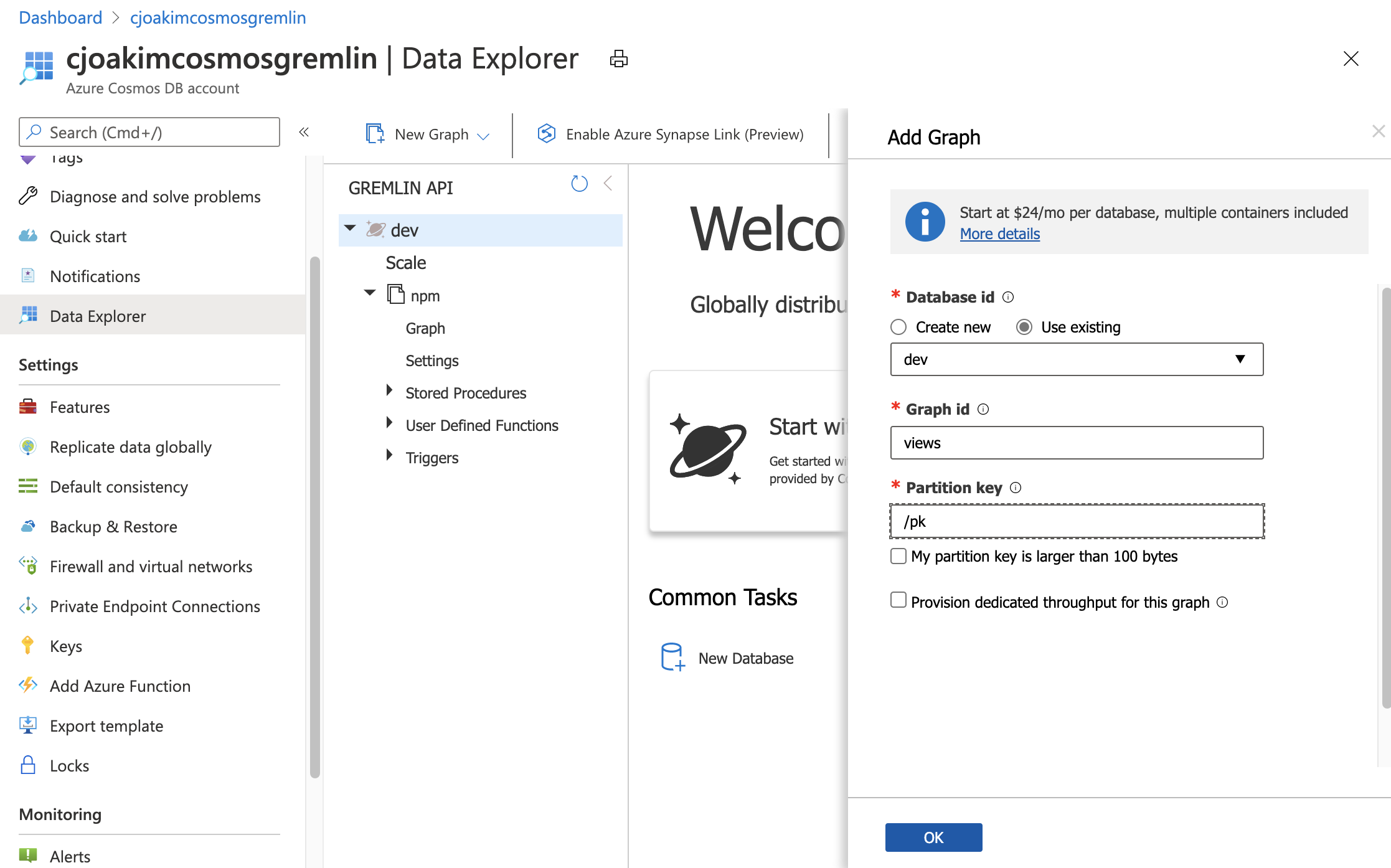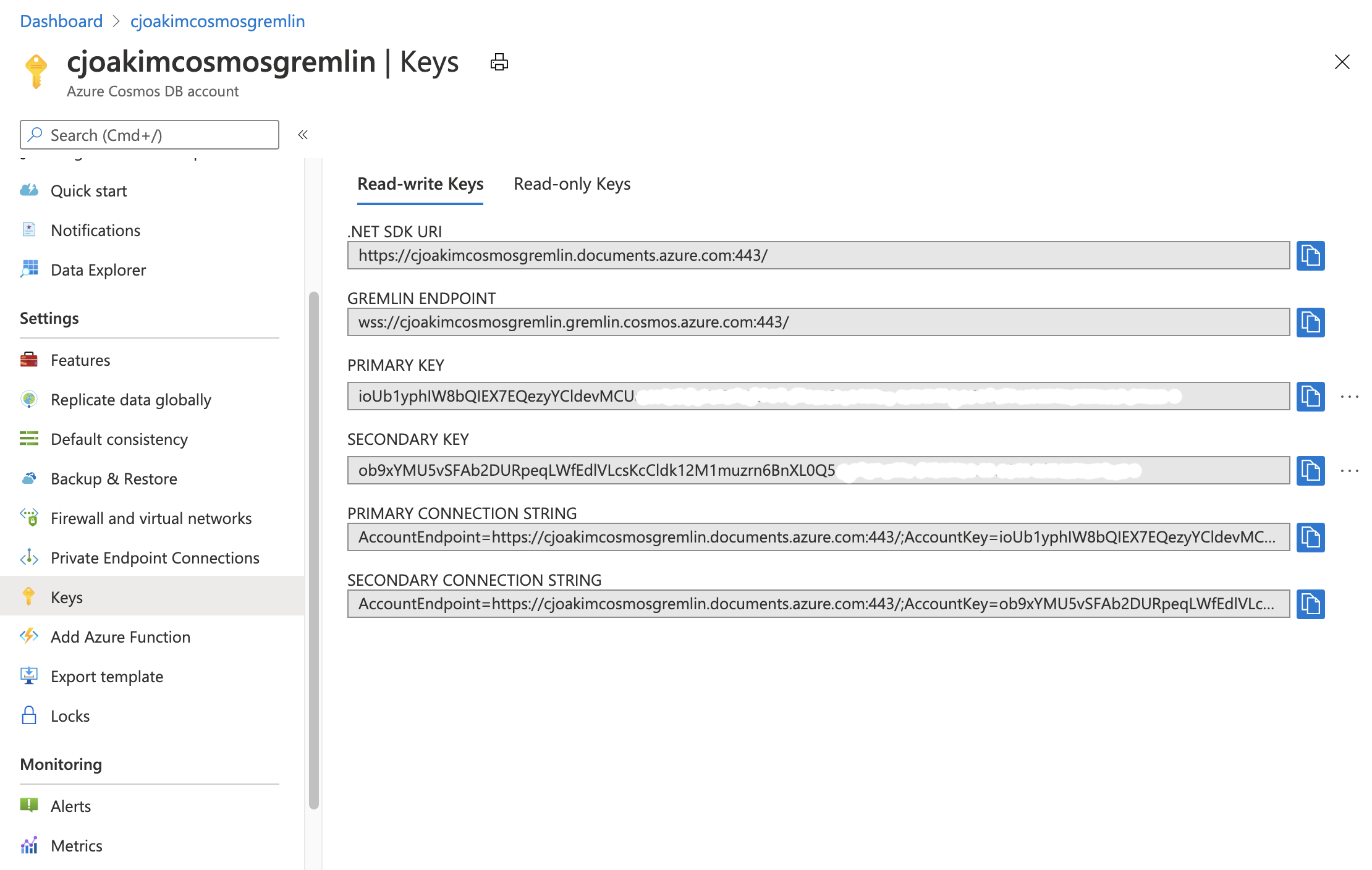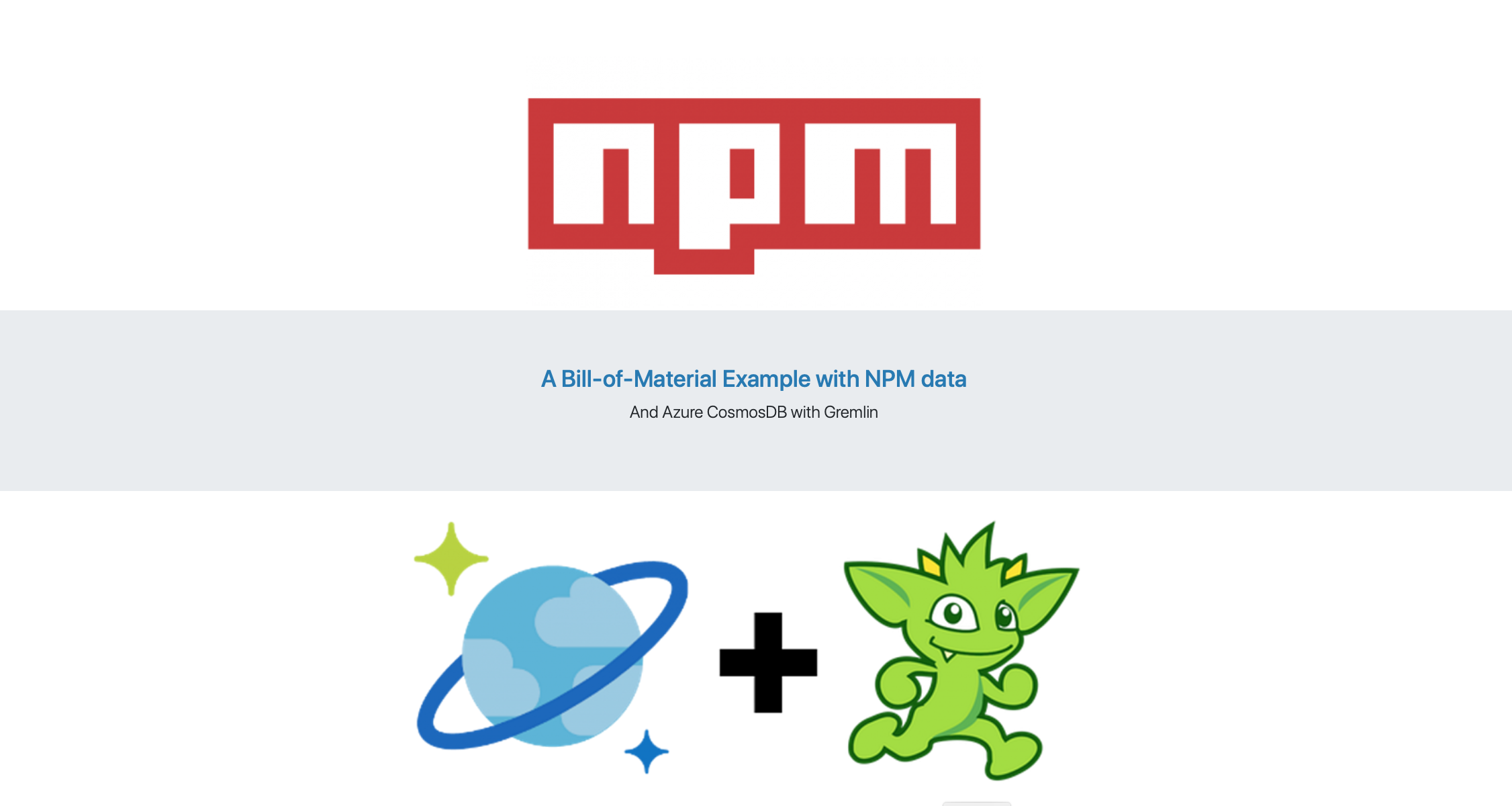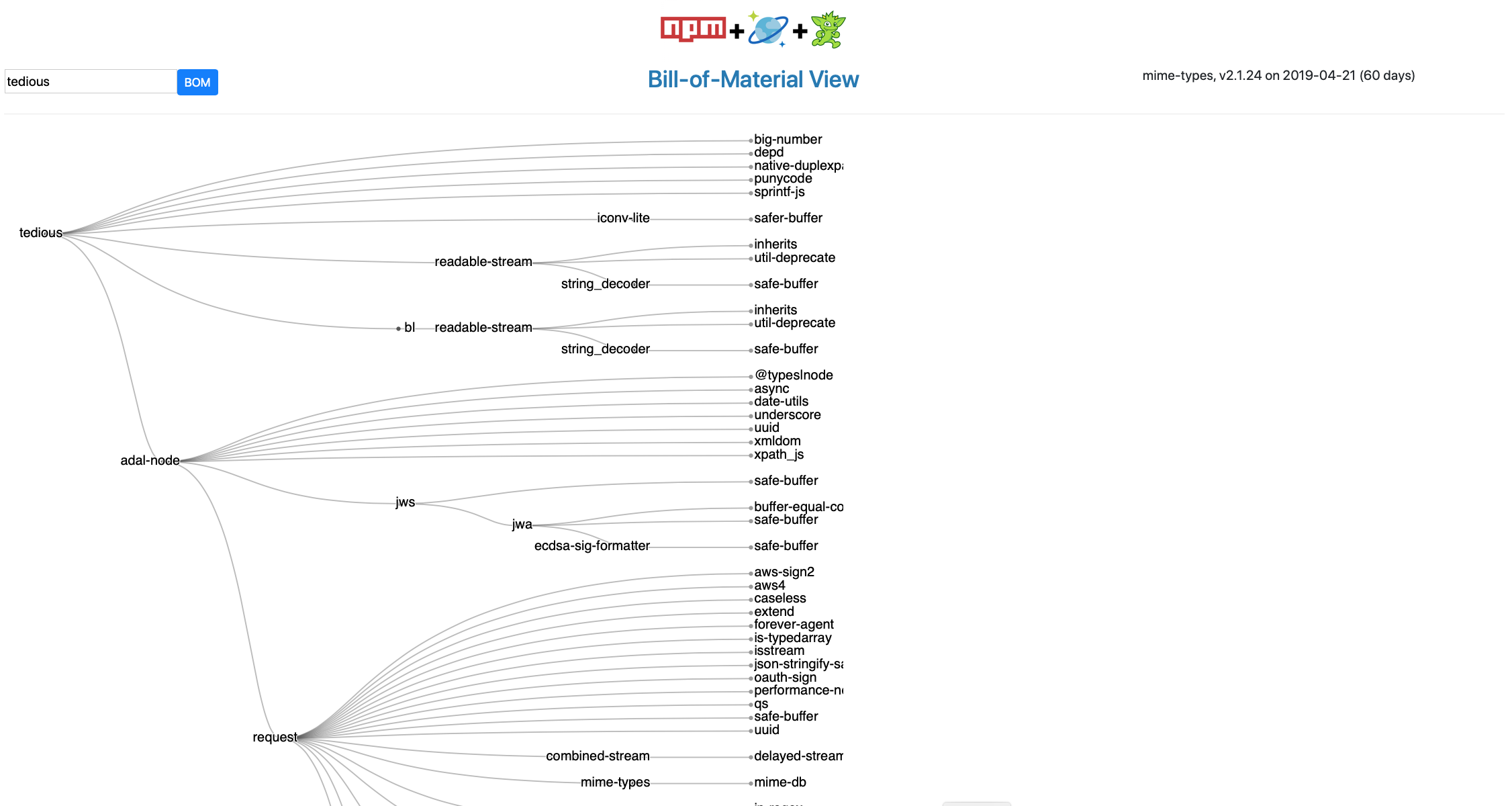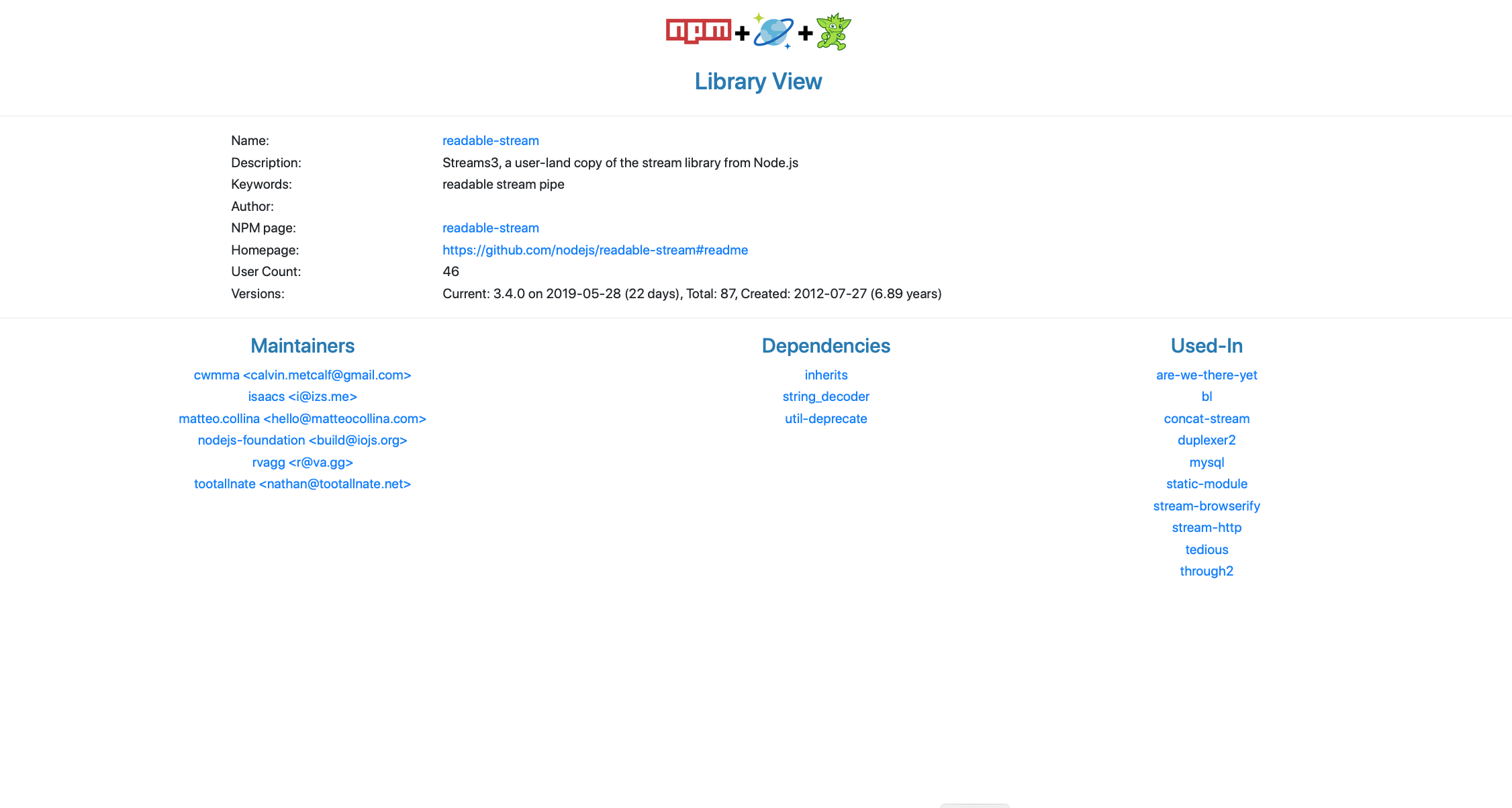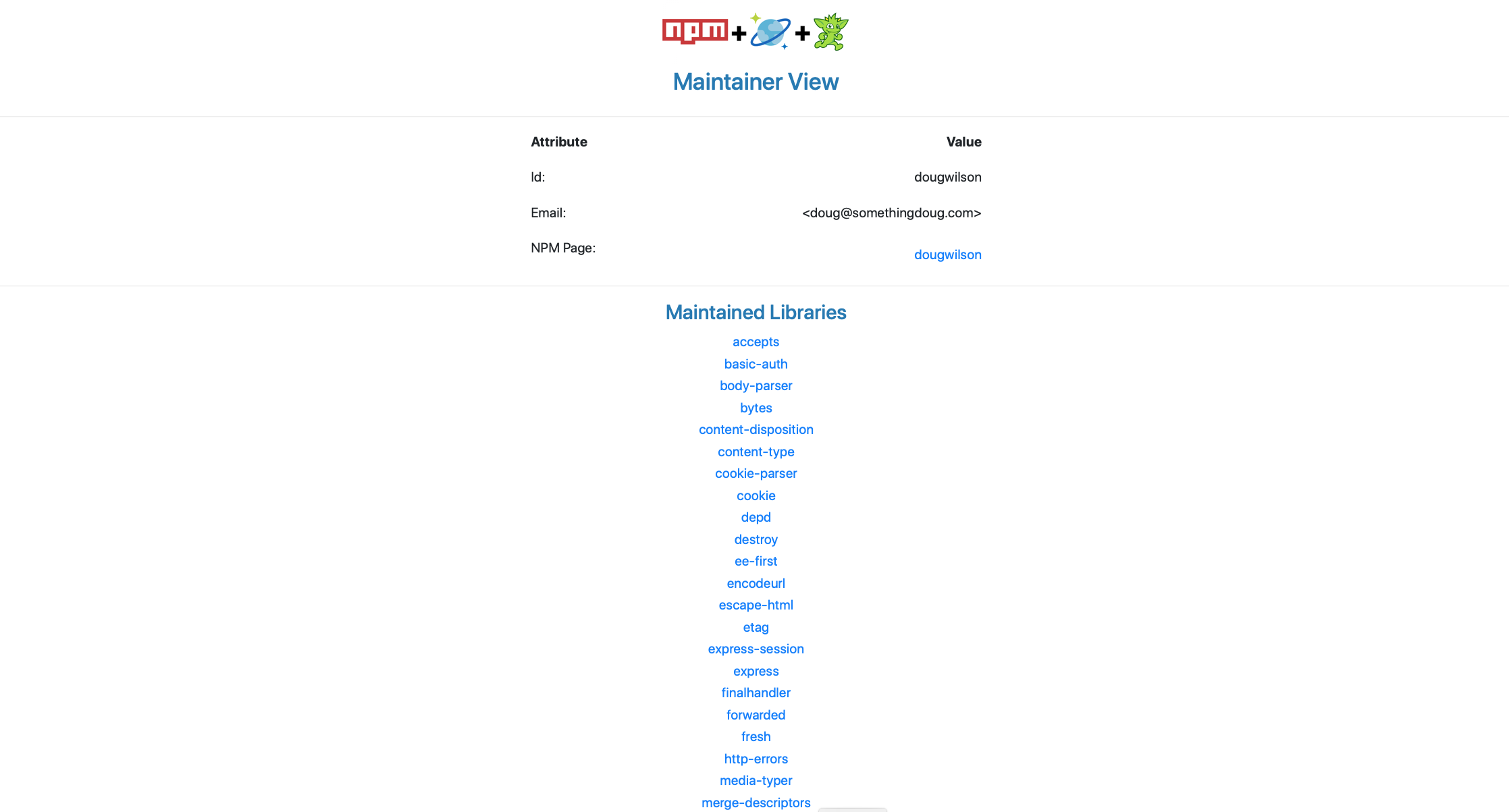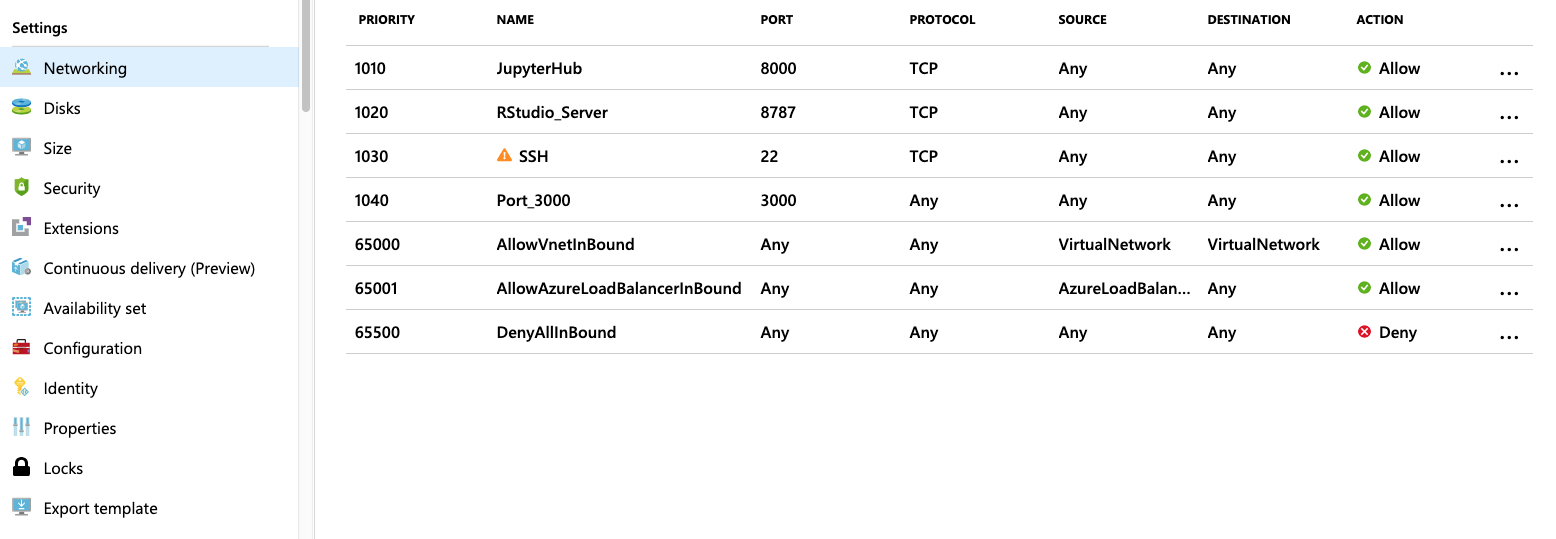| page_type | languages | products | description | urlFragment | ||||
|---|---|---|---|---|---|---|---|---|
sample |
|
|
An example Bill-of-Material application with NPM data using Azure CosmosDB Graph/Gremlin database. |
azure-cosmos-db-graph-npm-bom-sample |
An example Bill-of-Material application with NPM data using Azure CosmosDB Graph/Gremlin database.
- Chris Joakim, Microsoft, Azure Cloud Solution Architect, Charlotte
- Luis Bosquez, Microsoft, Azure CosmosDB Program Manager, Redmond
In our work with Azure CosmosDB we've seen that Bill-of-Materials (BOM) is a common use-case for companies, especially in the manufacturing sector. The graph of their manufactured products, and their many nested components, is perfectly suited for CosmosDB with the Gremlin Graph API.
Industry and company-specific product and component data, however, is both proprietary as well as not immediately relatable to most readers. We wanted to create a BOM sample application with data that was immediately relatable to most Information Technology audiences. Therefore, we chose the domain of software, since software end-products are typically composed of a nested graph of software libraries (i.e. - manufacturing components), and IT audiences innately understand this.
We considered using NuGet (DotNet), MavenCentral (Java), and PyPI (Python) as the datasource. But we chose
npm (Node Package Manager) in the Node.js and JavaScript ecosystem as Node.js is
fast-growing, appeals to a wide-audience, has great CLI tooling, and CosmosDB itself is JavaScript and JSON oriented.
Given the NPM orientation of this project, Node.js and JavaScript was chosen as the implementation language. JavaScript is widely supported in Azure PaaS services - such as Azure App Service, Azure Functions, and even in CosmosDB for server-side Stored Procedures, Triggers, and UDFs. It is worth noting that the free and cross-platform Visual Studio Code editor was used for the development of this project. Visual Studio Code is itself implemented in Node.js.
This application uses a Azure CosmosDB account, with the Gremlin API, as its sole datastore. There is a batch process which "spiders" npm for information about npm libraries, wrangles this JSON data, and then loads it into CosmosDB. There is also a web application, in the webapp/ directory, built with Node.js and Express which queries and displays the CosmosDB data. The open-source JavaScript library D3.js is used to visualize the graph data.
The database design includes two graphs, or containers. One contains the Graph data, with the Vertices being the NPM Libraries and their Maintainers, with Edges connecting libraries to their dependent libraries. Edges also connect the Maintainers to their respective libraries.
The second container in an implementation of the concept of materialized views; a set of data pre-aggregated and pre-processed so as to enable faster queries at runtime. For example, some of the pre-aggregated data answers the question: "Where else is this library/component used?" and "What other packages does this Maintainer work on?". Additionally, the materalized views contain pre-calculated library ages - in days and years, based on their original and current version dates. Pre-aggregating data such as this can significantly reduce the RU usage for CosmosDB users, and thus is why we are featuring materialized views in this sample BOM project.
What's very interesting about the materialized views in this project is that they are accessed via the CosmosDB SQL API rather than the Gremlin API. The materialized views are queried efficiently in this project via their partition key attribute whose name is simply 'pk'. This is actually a best practice - to name your partition key attributes with a generic name like 'pk' or 'partition_key' rather than a given business-oriented attribute name.
This is currently the only case where a single Azure CosmosDB account can be accessed via two programatic APIs; in this case a Gremlin account accesssed via the Gremlin and SQL APIs.
The advantage of this approach is that your BOM data is in one database, with independent and independently scalable
graph and view collections. It enables expressive graph traversal via the Gremlin API, and also very efficient
queries via the SQL API.
See file webapp/dao/cosmosdb_dao.js which implements the DAO Design Pattern for both the Gremlin and SQL APIs.
- https://azure.microsoft.com/en-us/services/cosmos-db/
- https://docs.microsoft.com/en-us/azure/cosmos-db/gremlin-support
- https://tinkerpop.apache.org/
- https://www.npmjs.com
- https://www.npmjs.com/package/@azure/cosmos
- https://www.npmjs.com/package/gremlin
- https://docs.microsoft.com/en-us/javascript/api/overview/azure/?view=azure-node-latest
- https://github.com/Azure-Samples/azure-cosmosdb-graph-bulkexecutor-dotnet-getting-started
Provision an Azure CosmosDB account, in your subscription, which uses the Gremlin/Graph API.
Then create a new database in your CosmosDB Graph account, as shown below. Create a database named dev with a container named npm. Specify a partition key named /pk. Optionaly check the Provision database throughput checkbox so that the RUs are shared amongst the several containers in the database, and specify 1,000 RUs.
Also create a second collection named views in the dev database, as shown below, also with a partition key named /pk.
Then, go to the Keys panel, as shown below, and set the following environment variables on your computer based on the values you see in Azure Portal for your account.
Note, the values shown below are just examples; your values will be different.
AZURE_COSMOSDB_GRAPHDB_ACCT=cjoakimcosmosgremlin
AZURE_COSMOSDB_GRAPHDB_COLNAME=npm
AZURE_COSMOSDB_GRAPHDB_CONN_STRING= ...secret...
AZURE_COSMOSDB_GRAPHDB_DBNAME=dev
AZURE_COSMOSDB_GRAPHDB_GRAPH=npm
AZURE_COSMOSDB_GRAPHDB_KEY= ...secret...
AZURE_COSMOSDB_GRAPHDB_URI=https://cjoakimcosmosgremlin.documents.azure.com:443/
AZURE_COSMOSDB_GRAPHDB_VIEWS=views
PORT=3000 (Also add this environment variable for the localhost webserver port)
The batch processing does the following:
-
Starts with a hand-edited list of seed npm libraries that are interesting to you.
-
Programatically invoke the npm cli to recursively Spider npm for information about each library.
- The spider process starts with your hand-edited list of seed npm libraries
- The spider will iterate n-number of times to get the dependencies of those seed libraries
- Then dependencies of those libraries, and their dependencies, etc, etc
- The command npm view library -json is executed for each library and the JSON response is captured
-
Wrangle the JSON files for each library that are captured in the Spidering process.
-
Generate Gremlin load statements, from the Wrangled data, to insert the Vertices and Edges for the npm graph.
- The Vertices are the npm libraries as well as their Maintainers
- Edges connect one library to another in a uses or used_by relationship
- Edges also connect the Maintainers to each Library they maintain
- Currently there isn't a knows Edge from one Maintainer to another within a Library.
-
Load the Azure CosmosDB/Graph database from the generated Gremlin statements
Since npm and thus JavaScript is the subject of this Graph, the implementation code is Node.js. This Node.js code is portable to Windows, Linux, and macOS. Both Linux and macOS bash shell scripts (.sh) and Windows PowerShell Scripts (.ps1) are provided in this repo.
First clone this repository and install the npm libraries necessary for this project in the project root directory.
$ git clone git@github.com:Azure-Samples/azure-cosmos-db-graph-npm-bom-sample.git
$ cd azure-cosmos-db-graph-npm-bom-sample
$ mkdir tmp
$ npm install Edit file *seeds.txt, the execute the following:
$ node main.js seed2jsonThis creates file data/seed_libraries.json
Then execute the npm "Spidering" process, with 10 iterations.
$ ./spider_npm.shThe above Spidering process will take roughly 10-minutes to execute, depending on the number of seed libraries and your network bandwidth.
Then execute the data-wrangling and gremlin-statement-generation process:
$ ./wrangle_npm_data.shNote that the Spidering process is intentionally decoupled from the Wrangling process, and that intermediate files are produced by the Wrangling process to increase clarity and understanding.
Finally, load your Azure CosmosDB Graph database, npm collection, with the generated file data/gremlin/gremlin_load_file.txt.
Here are few sample entries in this file, formatted and commented for readability:
# Create the Vertex for the "mssql" npm library
g.addV('library')
.property('pk','mssql')
.property('id','mssql')
.property('desc','Microsoft SQL Server client for Node.js.')
.property('name','mssql')
# Create the Vertex for the "tedious" npm library
g.addV('library')
.property('pk','tedious')
.property('id','tedious')
.property('desc','A TDS driver, for connecting to MS SQLServer databases.')
.property('name','tedious')
# Create an Edge declaring that mssql "uses" the tedious library
g.V(['mssql','mssql'])
.addE('uses_lib')
.to(g.V(['tedious','tedious']))
# Create an Edge declaring that tedious "is used by" the mssql library
g.V(['tedious','tedious'])
.addE('used_by_lib')
.to(g.V(['mssql','mssql']))
# Create the Vertex for one of the maintainers of the tedious library, luisbosquez.
g.addV('maintainer')
.property('pk','MAINT-luisbosquez')
.property('id','MAINT-luisbosquez')
.property('email','<lbosq@microsoft.com>')
.property('mid','luisbosquez')
.property('libs','tedious')
# Create an Edge declaring that luisbosquez maintains the tedious library.
g.V(['MAINT-luisbosquez','MAINT-luisbosquez']).addE('maintains').to(g.V(['tedious','tedious']))
$ ./load_gremlin_graph.shWhen the load process reaches end-of-file, the program will display a line of output like the following. This is normal, just CTRL-C in that Terminal to end the process.
load_next_row 4685 : undefinedAlso load the Azure CosmosDB Graph database, views collection, with the materialized views.
$ ./load_materialized_views.sh {
"name": "express",
"desc": "Fast, unopinionated, minimalist web framework",
"keywords": [
"express",
"framework",
"sinatra",
"web",
"rest",
"restful",
"router",
"app",
"api"
],
"dependencies": {
"accepts": "~1.3.7",
"array-flatten": "1.1.1",
"body-parser": "1.19.0",
"content-disposition": "0.5.3",
"content-type": "~1.0.4",
"cookie": "0.4.0",
"cookie-signature": "1.0.6",
"debug": "2.6.9",
"depd": "~1.1.2",
"encodeurl": "~1.0.2",
"escape-html": "~1.0.3",
"etag": "~1.8.1",
"finalhandler": "~1.1.2",
"fresh": "0.5.2",
"merge-descriptors": "1.0.1",
"methods": "~1.1.2",
"on-finished": "~2.3.0",
"parseurl": "~1.3.3",
"path-to-regexp": "0.1.7",
"proxy-addr": "~2.0.5",
"qs": "6.7.0",
"range-parser": "~1.2.1",
"safe-buffer": "5.1.2",
"send": "0.17.1",
"serve-static": "1.14.1",
"setprototypeof": "1.1.1",
"statuses": "~1.5.0",
"type-is": "~1.6.18",
"utils-merge": "1.0.1",
"vary": "~1.1.2"
},
"devDependencies": {
"after": "0.8.2",
"connect-redis": "3.4.1",
"cookie-parser": "~1.4.4",
"cookie-session": "1.3.3",
"ejs": "2.6.1",
"eslint": "2.13.1",
"express-session": "1.16.1",
"hbs": "4.0.4",
"istanbul": "0.4.5",
"marked": "0.6.2",
"method-override": "3.0.0",
"mocha": "5.2.0",
"morgan": "1.9.1",
"multiparty": "4.2.1",
"pbkdf2-password": "1.2.1",
"should": "13.2.3",
"supertest": "3.3.0",
"vhost": "~3.0.2"
},
"author": "TJ Holowaychuk <tj@vision-media.ca>",
"users": {
"422303771": true,
"coverslide": true,
"gevorg": true,
... many users ...
"payaamemami": true,
"pvoronin": true,
"spaceface777": true
},
"contributors": [
"Aaron Heckmann <aaron.heckmann+github@gmail.com>",
"Ciaran Jessup <ciaranj@gmail.com>",
"Douglas Christopher Wilson <doug@somethingdoug.com>",
"Guillermo Rauch <rauchg@gmail.com>",
"Jonathan Ong <me@jongleberry.com>",
"Roman Shtylman <shtylman+expressjs@gmail.com>",
"Young Jae Sim <hanul@hanul.me>"
],
"maintainers": [
"dougwilson <doug@somethingdoug.com>",
"jasnell <jasnell@gmail.com>",
"mikeal <mikeal.rogers@gmail.com>"
],
"version": "4.17.1",
"versions": [
"0.14.0",
"0.14.1",
"1.0.0",
"1.0.1",
"1.0.2",
"1.0.3",
... many versions...
"3.21.0",
"3.21.1",
"3.21.2",
],
"time": {
"modified": "2019-05-28T18:15:26.253Z",
"created": "2010-12-29T19:38:25.450Z",
"0.14.0": "2010-12-29T19:38:25.450Z",
"0.14.1": "2010-12-29T19:38:25.450Z",
... many versions ...
"4.17.1": "2019-05-26T04:25:34.606Z"
},
"homepage": "http://expressjs.com/",
"user_count": 2556,
"dependencies_count": 30,
"maintainers_count": 3,
"versions_count": 263,
"usage_count": 1,
"used_in": [],
"version_date": "2019-05-26T04:25:34.606Z",
"created_date": "2010-12-29T19:38:25.450Z",
"created_epoch": 1293651505450,
"version_epoch": 1558844734606,
"library_age_days": 3090,
"version_age_days": 20,
"pk": "express",
"key": "express",
"doctype": "library"
} {
"email": "<tj@vision-media.ca>",
"libs": [
"basic-auth",
"better-assert",
"bytes",
"callsite",
"commander",
"component-emitter",
"cookie-signature",
"debug",
"delegates",
"escape-html",
"growl",
"indexof",
"merge-descriptors",
"methods",
"object-component",
"range-parser",
"statuses",
"throttleit"
],
"pk": "tjholowaychuk",
"key": "tjholowaychuk",
"doctype": "maintainer"
}The Web Application for this project is implemented with Node.js and the Express web framework. D3.js is used in the client-side browser code for Graph Visualization.
$ cd webapp
$ npm install
$ ./webserver.sh
...
Express server listening on port 3000
...Then visit http://localhost:3000/ with your browser.
g.V().count()
g.V(["tcx-js","tcx-js"])
g.V(["tedious","tedious"])
g.V(["express","express"])
g.V(["tcx-js", "tcx-js"]).emit().repeat(outE("uses_lib").inV()).times(16).path().by("id")
g.V(["express", "express"]).emit().repeat(outE("uses_lib").inV()).times(16).path().by("id")
g.V(["MAINT-cjoakim","MAINT-cjoakim"])
g.V(["MAINT-luisbosquez","MAINT-luisbosquez"])
g.V(["MAINT-tjholowaychuk","MAINT-tjholowaychuk"])This project can, and has, been containerized as a Docker container. Using Docker can eliminate workstation OS and Node.js differences that may prevent you from running the project successfully.
See the Dockerfile which is used to create the container as follows:
docker build -t <your-name>/azure-cosmos-db-graph-npm-bom-sample .A pre-build container, available for your use, is on DockerHub as this name:
cjoakim/azure-cosmos-db-graph-npm-bom-sample:latestAlternatively, you can build your own Docker container like this:
Instead of:
docker build -t cjoakim/azure-cosmos-db-graph-npm-bom-sample .
Build your container with:
docker build -t <your-name>/<your-container-name> . See the comments in the Dockerfile regarding pushing your image to DockerHub or Azure Container Registry.
The container should run successfully on any Docker runtime.
The Azure Data Science Virtual Machine (Ubuntu DSVM) is a recommended platform. A Standard DS2 v2 (2 vcpus, 7 GiB memory) should be adequate to run this app. This can be provisioned in Azure Portal.
After the DSVM is created, in Azure Portal capture the IP address of your DSVM.
So as to enable access to the Node/Express/HTTP Server for this project, port 3000 on the DSVM needs to be enabled, as shown below (Port_3000) rule.
Remember, this web application is non-authenticated, so only public data should be contained in your CosmosDB instance and web app. The sample data in this project is public npm data.
Set the following environment variables in your shell; these are the same variables as described in the Azure Setup section above. These can be set in your ~/.bash_profile file.
AZURE_COSMOSDB_GRAPHDB_ACCT
AZURE_COSMOSDB_GRAPHDB_KEY
AZURE_COSMOSDB_GRAPHDB_URI
AZURE_COSMOSDB_GRAPHDB_DBNAME
AZURE_COSMOSDB_GRAPHDB_GRAPH
AZURE_COSMOSDB_GRAPHDB_VIEWSTo run this project on this DSVM, first ssh into the VM, then run these steps:
Set the above environment variables in your shell.
$ git config --global user.name "<your-name>"
$ git config --global user.email "<your-email-address>"
$ git clone git@github.com:Azure-Samples/azure-cosmos-db-graph-npm-bom-sample.git
$ cd azure-cosmos-db-graph-npm-bom-sample/
$ mkdir tmp/
$ ./sudo_docker_run_load_npm_collection.sh
$ ./sudo_docker_run_load_views_collection.sh
$ ./sudo_docker_run_webapp.sh
Then point your Web Browser to http://<your-dsvm-ip-address>:3000To stop the running webapp, open another terminal in the DSVM and run these commands:
$ sudo docker ps (see the container ID for the process you want to stop)
$ sudo docker stop -t 2 e7c7a67026b6Note: if you change the Docker container name then you also need to modify the several ...docker_run_... scripts to use your alternative container name, instead of cjoakim/azure-cosmos-db-graph-npm-bom-sample:latest.
Though the original implementation of this project was in Node.js, we also added a DotNet Core implementation in September 2020. Please see directory BOMClient.
You'll need to have DotNet version 5 installed on your computer to compile and execute this code. See https://dotnet.microsoft.com/download
$ cd BOMClient
$ dotnet --version
5.0.101
$ dotnet build
$ dotnet list package
Project 'BOMClient' has the following package references
[net5.0]:
Top-level Package Requested Resolved
> Gremlin.Net 3.4.9 3.4.9
> Microsoft.Azure.Cosmos 3.15.1 3.15.1
> Microsoft.CSharp 4.7.0 4.7.0
> Newtonsoft.Json 12.0.3 12.0.3
$ mkdir tmp
$ dotnet run process_gremlin_commands ../data/gremlin/gremlin_load_file.txt > tmp/gremlin_load_file.txt
$ dotnet run load_materialized_views ../data/aggregated_libraries.json > tmp/load_materialized_views.txt
Edit file gremlin_queries.txt per your desired queries.
$ dotnet run process_gremlin_commands ../data/gremlin/gremlin_queries.txt
...
---
0 Command: g.V().count()
Result:
1147
x-ms-status-code : 200
x-ms-total-server-time-ms] : 29.6129
x-ms-total-request-charge] : 3.75
---
1 Command: g.E().count()
Result:
3538
x-ms-status-code : 200
x-ms-total-server-time-ms] : 17.4554
x-ms-total-request-charge] : 3.5500000000000003
---
2 Command: g.V(['tedious','tedious'])
Result:
{"id":"tedious","label":"library","type":"vertex","properties":{"pk":[{"id":"tedious|pk","value":"tedious"}],"desc":[{"id":"c060308c-a7f6-44bf-b772-ed4749c4ab76","value":"A TDS driver, for connecting to MS SQLServer databases."}],"name":[{"id":"3a6f513c-0fa5-4d03-ada3-667096743c86","value":"tedious"}]}}
x-ms-status-code : 200
x-ms-total-server-time-ms] : 31.922
x-ms-total-request-charge] : 4.1899999999999995
...

